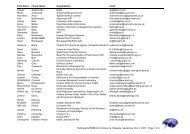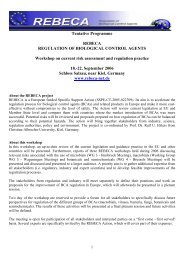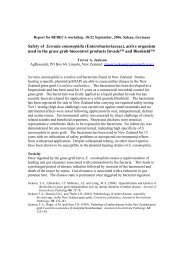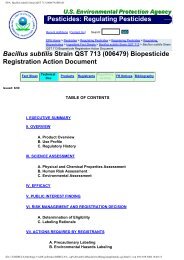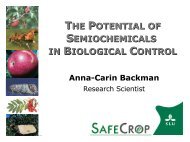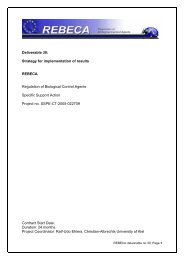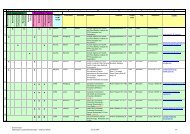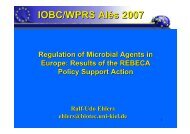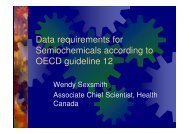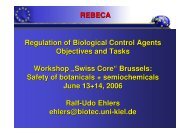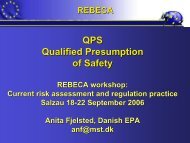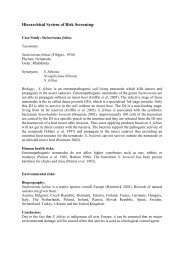Deliverable 28: Specification of low risk products REBECA ...
Deliverable 28: Specification of low risk products REBECA ...
Deliverable 28: Specification of low risk products REBECA ...
Create successful ePaper yourself
Turn your PDF publications into a flip-book with our unique Google optimized e-Paper software.
ERBIC Risk Indicator<br />
To our knowledge, the only attempt to numerically describe the environmental <strong>risk</strong>s<br />
<strong>of</strong> biological organisms was developed by the New Zealand Environmental Risk<br />
Management Authority (ERMA). First developed by Hickson et al. (2000) to assess<br />
the <strong>risk</strong>s related to the introduction <strong>of</strong> genetically modified organisms into New<br />
Zealand, this approach was further developed in the European Union research<br />
project ERBIC (Evaluating Environmental Risks <strong>of</strong> Biological Control Introductions<br />
into Europe; Hokkanen et al., 2003; van Lenteren et al., 2003). In part, this approach<br />
has also been adopted by the OECD for the review <strong>of</strong> inundative releases <strong>of</strong><br />
beneficial insects (OECD, 2004a).<br />
The underlying principle for the ERBIC/ERMA system is the definition <strong>of</strong> <strong>risk</strong> as the<br />
product <strong>of</strong> the probability <strong>of</strong> an effect, and the magnitude <strong>of</strong> its impact. The <strong>risk</strong> <strong>of</strong><br />
adverse effects <strong>of</strong> a certain organism is scored and calculated on the basis <strong>of</strong> this<br />
principle in five separate <strong>risk</strong> categories, which are then added up to form the overall<br />
<strong>risk</strong> indicator. The categories used are (i) the <strong>risk</strong> <strong>of</strong> establishment in non-target<br />
habitat, (ii) dispersal potential, (iii) host range, (iv) direct and (v) indirect effects.<br />
One advantage <strong>of</strong> this system is the very simple calculation and ease with which to<br />
interpret the <strong>risk</strong> score, hence al<strong>low</strong>ing a direct and meaningful comparison between<br />
different agents.<br />
The authors <strong>of</strong> the ERBIC report have attempted to compare the obtained <strong>risk</strong> scores<br />
to values obtained for some conventional chemicals and microbial control agents for<br />
illustrative purposes. While this may be useful for a rough comparison, it is necessary<br />
to exercise caution when applying the system beyond its original scope without<br />
modification, because the <strong>risk</strong> categories were clearly defined with the goal <strong>of</strong><br />
assessing insect biocontrol agents.<br />
In the context <strong>of</strong> this paper, a key weakness <strong>of</strong> the ERBIC/ERMA approach is that<br />
the applied <strong>risk</strong> categories are treated as independent <strong>of</strong> each other. As was<br />
discussed for the Norwegian Indicator, the simple addition <strong>of</strong> sub-indices does not<br />
reflect the complexity <strong>of</strong> the interaction between all defined categories.<br />
Despite this weakness, the basic principles in calculating sub-indices are valid and<br />
merit considerations when constructing a <strong>risk</strong> indicator for a related purpose.<br />
Defining a Risk Indicator suitable to compare biological and convential<br />
pesticides<br />
When building a <strong>risk</strong> indicator for pesticides, a number <strong>of</strong> factors need to be taken<br />
into account.<br />
Upfront, it is important to differentiate between ‘<strong>risk</strong> indicator’ systems, which are<br />
intended to summarize the environmental <strong>risk</strong>s for the purpose <strong>of</strong> making<br />
environmental policy decisions and communicating <strong>risk</strong>, and ‘impact assessment<br />
systems’, which can be used to accurately predict impacts on a particular<br />
environmental component (Levitan, 2000; Mineau et al., 2008). With the exception <strong>of</strong><br />
the NAESI approach, all the systems presented above fall under the ‘<strong>risk</strong> indicator’<br />
category.<br />
Upon review <strong>of</strong> several reports on this topic (Reus et al., 2002; Mineau & Whiteside,<br />
2005) we deemed the fol<strong>low</strong>ing factors to be most important for successfully deriving<br />
a <strong>risk</strong> indicator model to al<strong>low</strong> for a adequate comparison between conventional and<br />
microbial control agents:<br />
18



